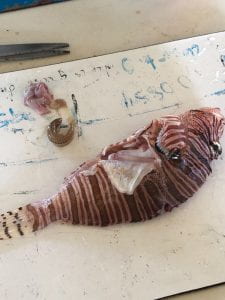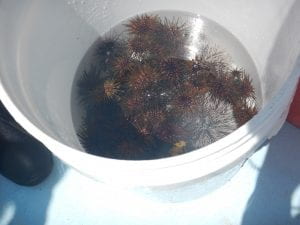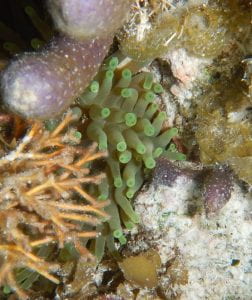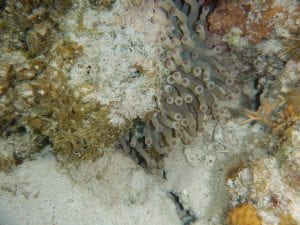Staring contest – you versus Barracuda. Ready… go! I was snorkeling around the dock in the seagrass when I saw this noticeably long, skinny, sand-colored fish with a long snout below me. I had been trailing behind all of the conspicuous fish I saw (trying to experience a day in the life of a fish), but this guy didn’t keep swimming along once he noticed me. He froze and made intense eye contact. At the time, I didn’t know he was a barracuda, but his gaze made me pretty uncomfortable, so after a minute stare-down, I fled.
Moving on quickly, I scanned the seagrass to see what else I could spot. There lay a sea anemone, tucked away under the grass; true (shell-producing) crabs climbing around; and some tiny, rock-colored fish (likely gobies or blennies) weaving in and out of the grass stalks. When we first entered the water to practice snorkeling, the seagrasses seemed lifeless, dusty, and mossy, but after staring for a minute, their species richness, hiding in plain sight, revealed itself. Making our way back to the dock, we interrupted a massive (1-2 thousand) school of jackfish and saw a nurse shark swimming back and forth through the coverage of the seagrass. Today I learned that seagrass ecosystems are super underrated.
After lunch, we squeezed on our super suits (our full-body, nylon watersuits) and boated out to the further reefs, with water clear as day and sponges galore. I was able to photograph and identify most of the sponges around with the help of my taxon ID sheet: yellow tube sponges, lavender rope sponges, scattered pore rope sponges, fire sponges, and chicken liver sponges. I’m guessing that it’s called that because it looks like chicken liver.

(Chicken Liver Sponge – IStock)
(Yellow Tube Sponge – 05/25/25)
(Yellow Scattered Pore Rope Sponge – 05/25/25)
But all of the sun of the day cooked me a bit. Sohee and I swam over to the calmer seagrasses to fight off the sea sickness, where we continued to sea super neat organisms. When Dr. Evans came to check in on us, he set his hand down on a “rock” that jumped up and darted away, better described as a flounder fish.
(Seagrass Pause – 05/25/25)
I’m excited to explore this new ecosystem, but without the shade of the rainforest’s tree canopy, I think I need to pace myself over these next few days to avoid shriveling up. I’m going to nap with a fan to replenish for a day of snorkeling (and sponge IDing!) tomorrow.
Peace out,
Lily H. 🙂 2025












